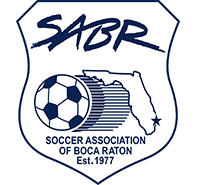Field Safety: Goals & Lightning Procedures
Soccer Goals
Due to the number of injuries each year that occur because of unsecured goals, IT’S MANDATORY that you as the referee check to make sure each goal is properly secured. If not, then make sure they are secured with sand bags, etc. Make sure that you also secure any unused goals near spectators. If you need help, be sure to enlist the help of the coaches, SABR Administrators, parents, etc. If you cannot find something to secure them, then please ask the coaches to call the City at 347-3950. If they cannot reach them, then please have the coaches call the Director of Referees or the Age Group Division Representative.
It is the responsibility of the coaches to move the goals when advised to do so by the referees. Referees should only move goals to adjust the position of the posts on the goal lines.
Do not allow any game to proceed without the goals properly anchored!
Lightning
NOAA, National Weather Service provides some advice on lightning safety:
NOAA, National Weather Service
Office of Climate, Water, and Weather Services 1325 East West Highway
Silver Spring, MD 20910
- The “30-30 Rule” offers easy to follow lightning safety guidance. When you see lightning, count the time until you hear thunder. If that time is 30 seconds or less, the thunderstorm is close enough to be dangerous. Seek shelter. If you can't see the lightning, just hearing the thunder is a good back-up rule. Wait at least 30 minutes after the lightning flash before leaving shelter.
- No place OUTSIDE is safe during a thunderstorm!
- A house, or other fully enclosed building with wiring and plumbing offers your best protection against lightning. Once inside stay off telephones, computers and other electrical appliances and stay away from sinks, showers, indoor pools and other plumbing. Don't watch lightning from windows or doorways. Inner rooms are safer.
- A car with a metal roof and sides is your second best protection against lightning. As in a house, don't touch any conducting paths leading outside. It is the metal shell that protects you, not the rubber
- Lightning is the #2 weather killer in the United States over a 30-year period, killing more than hurricanes and tornadoes combined! Only floods kill
- Lightning is the #1 weather killer in Florida, killing more than all other weather sources combined!
- Florida leads the U.S. in lightning deaths, injuries, and casualties!
- Lightning kills about 60 people in the U.S. each year and inflicts severe life-long debilitating injuries on at least a 1,000 people a
- Long-term lightning symptoms are primarily neurological and are difficult to diagnose. Though very variable, some of the more frequent symptoms include memory deficit, sleep disturbance, dizziness, and chronic pain. Lightning survivors sometimes have trouble processing information, are easily distracted, and have personality changes. Symptoms may not appear until months after the lightning strike. The ‘lightning strike and electric shock survivors, international' is the main support group for lightning survivors ( lightning-strike.org ).
- Lightning causes about $5 billion of economic impact in the U.S. each year!
- Pennsylvania leads the U.S. in lightning damage!
- The odds of an individual being a lightning casualty in a year in the U.S. is about 280,000-to-1 – if you're an average person, in an average location, with average outside activities, and average lightning safety behavior. That's about 3,000-to-one over your lifetime, with about 300-to-one odds of being seriously affected by a family member or friend being a lightning survivor. In Florida, it's closer to 80,000-to-1 per year of being struck, 1,000-to-one in a lifetime, and 100-to-one of being seriously affected.
- The odds of an individual being killed by lightning each year in the U.S. is about 3 million-to-1, if you're an average person, in an average location, with average outside activities, and average lightning safety behavior. That's about 35,000-to-one over a life time, and about 3,000-to-one of being seriously affected by a family member or friend being killed by lightning. In Florida, it's closer to 900,000-to-one per year, or 12,000-to-1 over a lifetime, and 1,000-to-1 of being seriously
- For more information, go to lightningsafety.noaa.gov
In addition, all of the City of Boca Raton fields have lightning detectors; If you hear the lightning detector sound, please remind the coaches, players and spectators that they need to leave the field and seek shelter until the lightning detector sounds again as three short bursts indicating it is safe to return.
REMEMBER THAT THE LIGHTNING DETECTORS HAVE BEEN KNOWN TO FAIL, THUS PLEASE BE SURE TO RELY ON YOUR COMMON SENSE AND IF THE “30-30” RULE INDICATES YOU SHOULD LEAVE THE FIELD, AND YET THE DETECTOR HAS NOT SOUNDED, BE SURE TO USE YOUR BEST JUDGEMENT AND FOLLOW THE NOAA RECOMMENDATIONS. BETTER TO BE SAFE THAN SORRY.
The City Field Condition Hotline is 561-367-7068.
